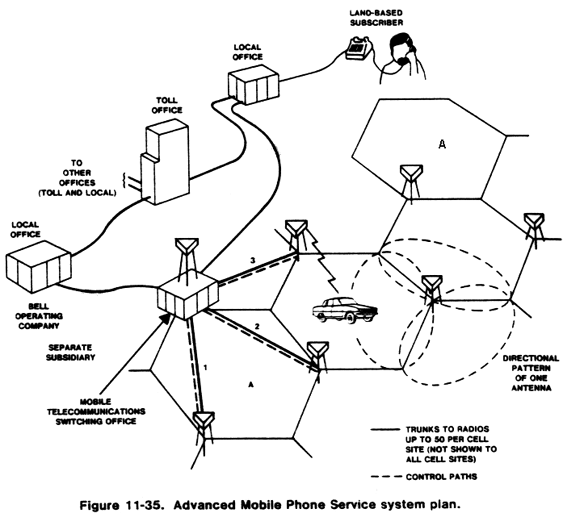|


- (Page 13) Cellular Telephone Basics continued : Bell System Overview

From: A History of Engineering and Science in the Bell System: Communications Sciences (1925 -- 1980)
Advanced Mobile Phone Service (continued)
Cellular Concept. Although the MJ and MK automatic systems offer some major improvements in call handling, the basic problems, few channels and the inefficient use of available channels still limit the traffic capacity of these conventionally designed systems. Advanced Mobile Phone Service overcomes these problems be using a novel cellular approach. It operates on frequencies in the 825- to 845 MHz and 870-to 890-MHz bands recently made available by the FCC. The large number of channels available in the new bands has made the cellular approach practical.A cellular plan differs from a conventional one in that the planned reuse of channels makes interference, in addition to signal coverage, a primary concern of the designer. Quality calculations must take the statistical properties of interference into account, and the control plan must be robust enough to perform reliably in the face of interference. By placing base stations in a more or less regular grid (spacing them uniformly), the area to be served is partitioned into many roughly hexagonal cells, which are packed together to cover the region completely. Cell size is based on the traffic density expected in the area and can range from 1 to 10 miles in radius.
Up to fifty channels are assigned to each cell to achieve their regular reuse and to control interference between adjacent cells. This is illustrated in Figure 11-35, where cell A' can use the same channels as cell A. Because of the inverse power law of propagation, the spatial separation between ceils A and A' can be made large enough to ensure statistically that a signal-to-interference ratio greater than or equal to 17 dB is maintained over 90 percent of the area. Maintenance of this ratio ensures that a majority of users will rate the service quality good or better.
Cellular systems also differ from conventional systems in two significant ways:
High transmitted power and very tall antennas are not required.
Wide FM deviation is permissible without causing significant levels of interference from adjacent channels.

